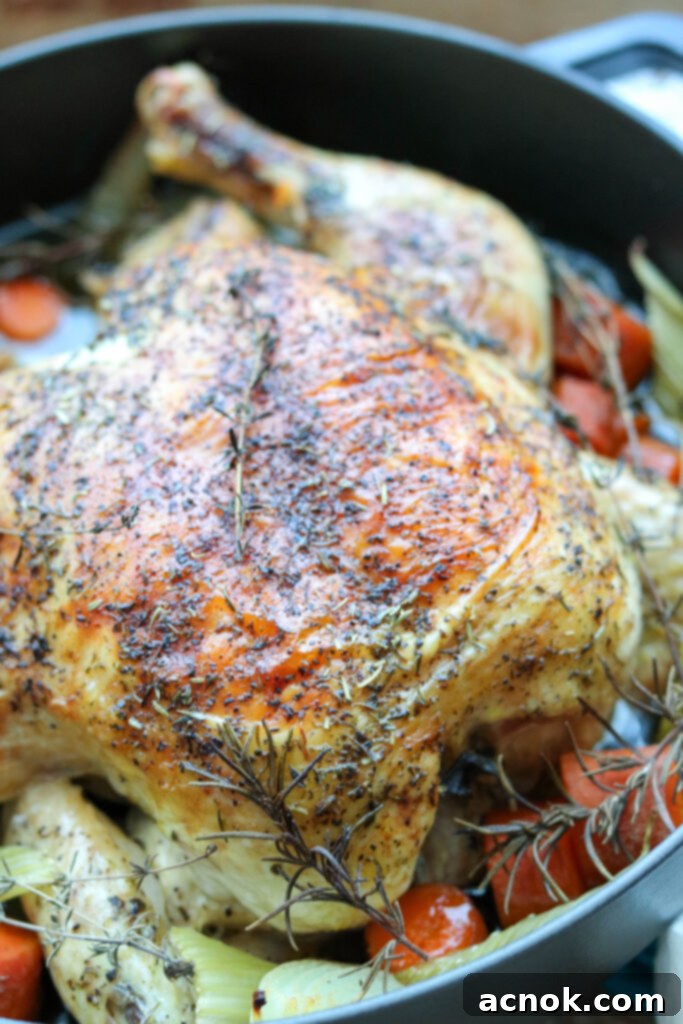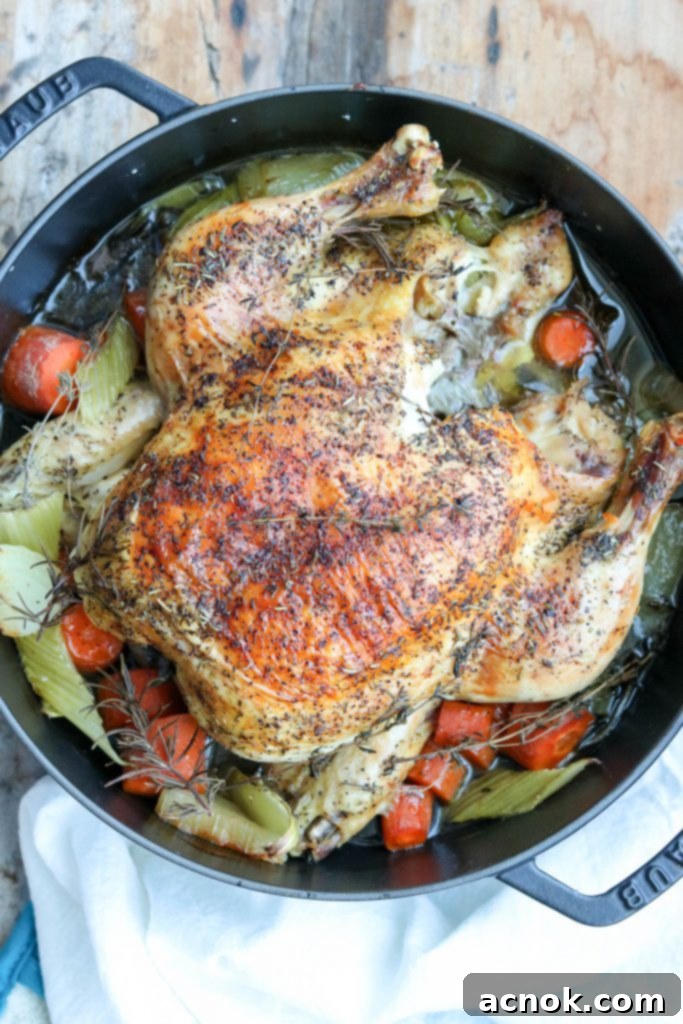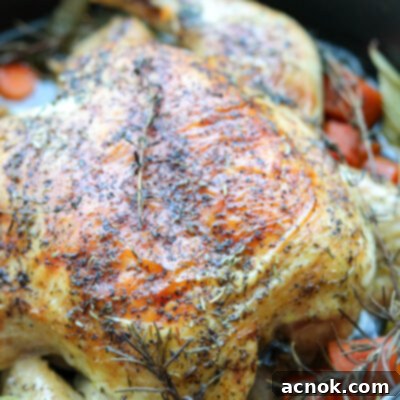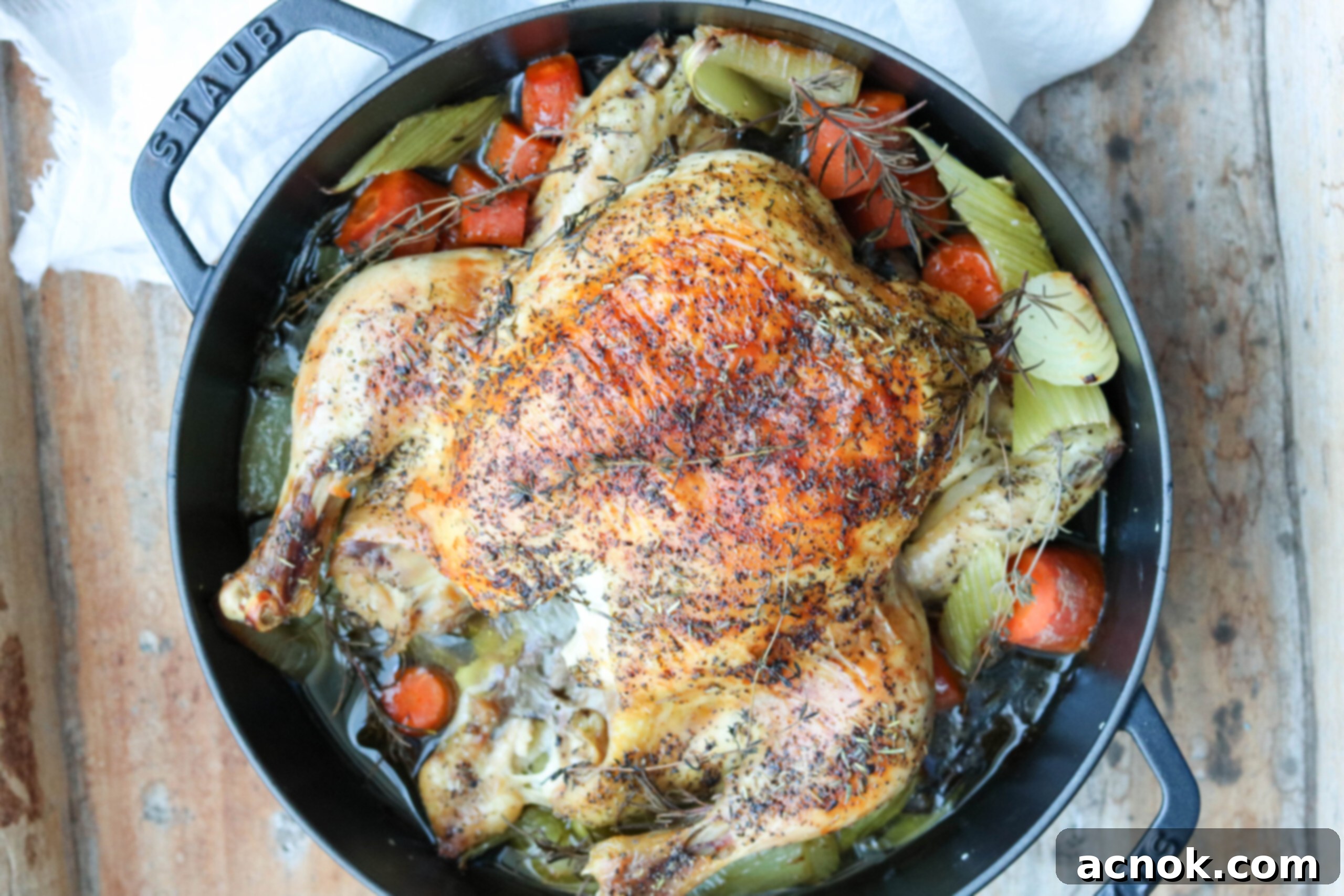The Ultimate Simple Herb Roast Chicken Recipe: Juicy & Flavorful Every Time
There are few culinary delights that evoke such a sense of comfort and warmth quite like a perfectly roasted chicken. For many, it’s more than just a meal; it’s a cherished Sunday evening tradition, a centerpiece for family gatherings, or simply a comforting dish to enjoy with a fine glass of wine and a simple, complementing side. The moment that rich, savory aroma begins to waft through the house, it instantly transforms the atmosphere, creating an anticipation much like the grand turkey at Thanksgiving. While the world offers countless methods to prepare a whole bird, from elaborate brines to complex stuffing, my personal preference leans towards a beautifully straightforward approach. This method not only simplifies the cooking process but consistently delivers a roast chicken that is tender, moist, and bursting with flavor every single time.

The secret to an exceptional roast chicken doesn’t lie in complicated techniques but rather in a few key principles: quality ingredients, thoughtful seasoning, and a reliable cooking process. I always strive to source the best bird available, whether it’s a free-range option from a local farm or the highest quality poultry I can find at my grocery store. Investing in a good chicken lays the foundation for a truly delicious meal. This guide will walk you through my go-to recipe, ensuring your next herb roast chicken is nothing short of spectacular, promising that coveted crispy skin and succulent meat that will have everyone asking for seconds.
Why This Simple Herb Roast Chicken Recipe Stands Out
In a culinary landscape filled with elaborate recipes, sometimes the most profound flavors come from the simplest preparations. This simple herb roast chicken recipe is a testament to that philosophy. It’s designed for anyone seeking a delicious, wholesome meal without the fuss, offering a reliable path to a perfectly cooked chicken. The beauty of this recipe lies in its balanced use of classic herbs – Herbes de Provence, fresh rosemary, thyme, and sage – which infuse the chicken with an incredible aromatic depth without overpowering its natural flavor. Coupled with a strategic roasting technique, this method guarantees juicy, fork-tender meat and delightfully crispy skin, turning an ordinary chicken into an extraordinary meal with minimal effort.
Beyond its incredible taste, this recipe is perfect for various occasions. It’s elegant enough for a special dinner, yet straightforward enough for a casual weeknight meal. The hands-on preparation is minimal, allowing you more time to relax while your oven does most of the work. The rich, herby aromas that fill your kitchen are an added bonus, making the entire cooking experience enjoyable from start to finish. If you’ve ever been intimidated by roasting a whole chicken, this recipe is your ideal starting point, promising consistently delicious results that will impress both your family and friends and quickly become a staple in your rotation.
Choosing the Perfect Bird: A Foundation for Flavor
The journey to an exquisite herb roast chicken begins long before you preheat your oven; it starts with selecting the right bird. The quality of your chicken significantly impacts the final taste and texture of your dish. Whenever possible, I highly recommend opting for a free-range, organic, or pasture-raised chicken. These birds often have a superior flavor profile, a firmer texture, and are typically raised under conditions that promote better welfare and natural diets. While they might be a bit pricier, the difference in taste and overall quality is undeniably worth the investment for a truly remarkable meal.
If free-range options aren’t readily available, don’t fret. Focus on finding the best quality whole chicken you can at your local supermarket. Look for chickens that appear plump and have moist, unbroken skin. The size of your chicken will also influence the cooking time, with a standard 3-4 pound bird being ideal for this recipe, serving approximately four people generously. Larger chickens will naturally require longer roasting times. Remember, a well-chosen chicken is the first and most crucial step towards achieving that succulent, flavorful roast you’re dreaming of, so take a moment to select wisely.
Essential Preparation Steps for a Perfect Roast
Preparing to Roast: From Package to Pan
Once you’ve selected your chicken, the preparation process is straightforward but crucial for both hygiene and optimal cooking results. Begin by carefully unwrapping the chicken over your sink. This helps to contain any potential splashing of chicken juices, which can spread contamination to surrounding surfaces. Remove the bird from its packaging and place it on a clean dish or cutting board dedicated for raw poultry. Don’t forget to reach inside the cavity and remove the giblets (the neck, gizzards, heart, and liver), which are usually found in a small bag. These can be discarded or saved to make a flavorful homemade chicken stock, adding another layer of culinary depth to your cooking.
To Rinse or Not to Rinse? Understanding Food Safety
One of the most debated topics in chicken preparation is whether or not to rinse raw poultry. For years, many home cooks instinctively rinsed their chicken under running water, believing it removed bacteria and made the bird cleaner. However, current food safety guidelines, backed by organizations like the USDA and health authorities worldwide, strongly advise against rinsing raw chicken. The primary reason is that rinsing can inadvertently spread bacteria (such as Salmonella or Campylobacter) from the chicken juices to your sink, countertops, and other kitchen surfaces through aerosols, leading to a risk of cross-contamination that is far greater than any perceived benefit.
My method, and the recommendation from many culinary experts, is to pat the chicken completely dry with paper towels instead. This step is absolutely critical, regardless of whether you choose to rinse or not. A thoroughly dry surface is essential for allowing the skin to crisp up beautifully and achieve that coveted golden-brown, crackling finish during roasting. After handling raw chicken, whether you rinse it or just pat it dry, always wash your hands thoroughly with soap and warm water for at least 20 seconds. Additionally, clean and sanitize all surfaces and utensils that came into contact with the raw poultry to ensure maximum food safety in your kitchen. For more insights on this important topic, you can refer to this informative article.
Seasoning Your Chicken for Maximum Flavor
With your chicken prepped and thoroughly patted dry, it’s time for the star of the show: seasoning! This is where we infuse the bird with incredible, mouth-watering flavor. Begin by generously coating the entire exterior of the chicken with a good quality olive oil. The olive oil acts as a perfect binder for the seasonings, helps promote beautiful, even browning, and contributes to a deliciously moist and tender skin texture.
Next, sprinkle 3 teaspoons of high-quality Herbes de Provence evenly over the olive oil-coated skin. Herbes de Provence is a fragrant blend of dried herbs traditionally found in the Provence region of southeastern France, typically including savory, marjoram, rosemary, thyme, oregano, and sometimes lavender. This exquisite blend offers a complex, aromatic profile that perfectly complements the rich flavors of chicken. Don’t stop there; season the exterior generously with kosher salt and freshly ground black pepper. Remember, proper seasoning is absolutely key to a flavorful bird, so don’t be shy – cover every inch!
For an even deeper flavor penetration, don’t forget the inside of the cavity. Add a good pinch of Herbes de Provence, salt, and pepper into the bird’s cavity. You can also place half a lemon, a few cloves of smashed garlic, or an onion quarter inside for additional aromatic notes that will steam and infuse the chicken from within during roasting. This ensures that every part of the chicken, from the crispy skin to the succulent inner meat, is imbued with delicious, well-rounded flavor.
Setting the Stage: Your Roasting Pan and Aromatic Vegetables
Once seasoned, your chicken is ready for its roasting vessel. You have a couple of excellent options: a sturdy roasting pan or a heavy Dutch oven. Both work wonderfully, but each has slight advantages. A traditional roasting pan, especially one with a rack, allows for excellent airflow around the chicken, promoting incredibly even cooking and maximizing crispy skin development. If using a roasting pan without a rack, you can easily create a natural “rack” with aromatic vegetables, which is my preferred method as it also adds flavor to the drippings.
A Dutch oven, with its heavy construction and tight-fitting lid, is excellent for retaining moisture and creating a self-basting environment, leading to incredibly tender and fall-off-the-bone meat. If you opt for a Dutch oven, ensure it’s large enough for the chicken to sit comfortably without being cramped, allowing enough space for air and heat to circulate around it. The key is to select a vessel that accommodates the chicken well and facilitates even cooking.
Around the chicken, in your chosen pan, arrange a generous bed of thickly chopped carrots, onions, and celery. These classic “mirepoix” vegetables do more than just add flavor to the pan drippings for gravy; they also slightly elevate the chicken, preventing the bottom from getting soggy and promoting more uniform cooking. Additionally, tuck in fresh sprigs of Rosemary, Thyme, and Sage. These fresh herbs release their intoxicating aromas and essential oils as they heat, further perfuming the chicken and filling your entire kitchen with an irresistible fragrance. A final sprinkle of salt and pepper over these vegetables ensures they too are seasoned perfectly as they caramelize beautifully in the chicken drippings.
The Roasting Process: Achieving Perfection

With your oven preheated to 375 degrees Fahrenheit (190 degrees Celsius), carefully place your prepared roasting pan or Dutch oven with the seasoned chicken inside. The initial phase of roasting involves covering the chicken tightly with foil (if using a roasting pan) or simply placing the lid on your Dutch oven. This covered period is crucial for trapping steam and ensuring the chicken cooks through without drying out, making the meat incredibly tender and succulent. It essentially braises the chicken in its own juices and the aromatics.
Roast the chicken covered for approximately 1 hour. After this initial hour, it’s time to check on your bird and begin the browning process. Carefully remove the foil or Dutch oven lid. At this point, you’ll want to check the internal temperature of the chicken using a reliable meat thermometer. Insert the thermometer into the thickest part of the thigh, making sure not to touch the bone, as bone temperature can be misleading. The target internal temperature for fully cooked chicken is 165 degrees Fahrenheit (74 degrees Celsius). At this stage, it will likely need more cooking time, usually about another 20-30 minutes to reach its peak.
Before returning it to the oven, baste the chicken generously with the rich pan juices that have accumulated at the bottom of the pan. Basting not only adds incredible flavor but also helps the skin to brown beautifully and evenly, creating that desired crispy texture. Now, with the cover removed, continue roasting for another 20-30 minutes, or until the chicken reaches the desired internal temperature of 165°F and the skin is a magnificent golden brown and wonderfully crispy. Keep a close eye on it during this final uncovered period to prevent over-browning. The exposed roasting allows the skin to achieve that irresistible texture we all crave.
The Final, Crucial Step: Resting for Juiciness
Once your herb roast chicken has reached the perfect internal temperature and boasts a glorious golden-brown skin, resist the urge to carve it immediately. This is perhaps the most critical step for ensuring a truly juicy bird, a step often overlooked but vital for superior results. Carefully remove the chicken from the oven and transfer it to a clean cutting board or serving platter. Tent it loosely with foil – this helps keep it warm while allowing some steam to escape, preventing the skin from getting soggy – and allow it to rest for at least 15-20 minutes. During this resting period, the muscle fibers relax, and the juices, which have migrated to the center of the bird during cooking, redistribute themselves evenly throughout the meat. This results in a much juicier, more tender, and ultimately more flavorful chicken when carved.
After resting, carve the chicken and serve it with the beautifully roasted vegetables from the pan, which will be wonderfully tender and infused with all the rich chicken and herb flavors. These vegetables are a delicious side dish on their own. The pan drippings, rich with caramelized bits and savory juices, can also be easily used to make a quick, savory gravy, elevating your meal even further and ensuring no flavor goes to waste. This Simple Herb Roast Chicken is not just a recipe; it’s an invitation to enjoy a wholesome, comforting, and exquisitely flavorful meal that’s perfect for any occasion and surprisingly easy to achieve.
Serving Suggestions and Perfect Pairings
A simple herb roast chicken, with its robust flavors and comforting appeal, pairs wonderfully with a variety of side dishes. For a classic meal, consider serving it alongside creamy mashed potatoes or a hearty wild rice pilaf that can soak up all the delicious pan juices. Roasted root vegetables, in addition to those cooked with the chicken, such as parsnips or sweet potatoes, would also be a fantastic complement. A crisp green salad with a light vinaigrette offers a refreshing contrast to the richness of the chicken.
When it comes to beverages, a medium-bodied white wine like a Chardonnay (unoaked or lightly oaked) or a Sauvignon Blanc would be delightful. For red wine enthusiasts, a lighter-bodied Pinot Noir or a Beaujolais would also complement the herby flavors without overpowering the dish. Don’t forget the leftover chicken! It’s fantastic for sandwiches, salads, quesadillas, or even in a chicken soup, making this recipe not just a single meal but a foundation for multiple delicious creations throughout the week.

Simple Herb Roast Chicken
Ana | Claudia’s Table
May 6, 2020
Pin Recipe
Equipment
-
Roasting pan or dutch oven
Ingredients
- 1 whole chicken raw
- 3 tsp Herbes de Provence dried
- 1 onion white or yellow, cut into thick chunks
- 2-3 celery ribs, chopped into large pieces
- 2-3 carrots cut into large chunks.
- 1-2 tbsp olive oil
- 4-6 sprigs Rosemary fresh
- 6-8 sprigs Thyme fresh
- 6 leaves Sage fresh
- salt kosher
- pepper
Instructions
-
Preheat oven to 375 degrees Fahrenheit (190°C).
-
Carefully remove the chicken from its package, doing so over the sink to prevent splashing of juices and potential contamination. Remove the giblets from the cavity.
-
Whether you choose to rinse the chicken or not, pat it completely dry with paper towels. This step is crucial for crispy skin. Ensure you wash your hands thoroughly with soap and warm water after handling raw poultry.
-
Liberally coat the entire chicken with olive oil. Then, season generously with Herbes de Provence, salt, and pepper on all sides, ensuring even coverage.
-
Also, add some of the Herbes de Provence, salt, and pepper to the inside of the cavity for enhanced flavor.
-
Place the chicken in your roasting pan or Dutch oven. Arrange the thickly chopped onions, celery, and carrots around the chicken. Tuck the fresh sprigs of Rosemary, Thyme, and Sage among the vegetables. Season the vegetables with additional salt and pepper.
-
Cover the roasting pan tightly with foil or place the lid on the Dutch oven. Roast in the preheated oven for 1 hour.
-
After 1 hour, carefully remove the foil or pan lid. Check the internal temperature of the chicken in the thickest part of the thigh (avoiding bone). Baste the chicken generously with the accumulated pan juices.
-
Return the uncovered chicken to the oven and roast for another 20-30 minutes, or until the internal temperature reaches 165 degrees Fahrenheit (74°C) and the skin is beautifully golden brown and crispy. Baste once more during this final roasting period if desired.
-
Once cooked, remove the chicken from the oven and transfer it to a cutting board. Tent loosely with foil and let it rest for about 15-20 minutes before carving. This crucial step ensures a juicy and flavorful chicken.
Notes
Click here.
Nutrition
Nutritional information is calculated online and should be used as a guide.
All content and photographs ©Claudia’s Table and claudiastable.com
